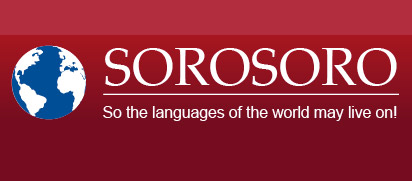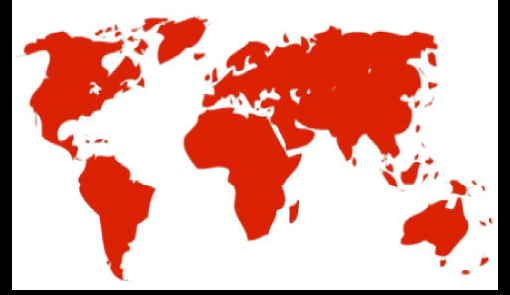Print  |
|


Colors
It is interesting to compare languages through their use of daily words and expressions which are (too often !) held as universal. Our shooting teams were requested to gather names of colors, numbers from 1 to 10 (although we know all populations do not necessarily use the same counting systems) as well as daily phrases from all their interlocutors in their respective languages.
These basic words often prove to be an efficient way of verifying similarities between languages belonging to the same linguistic group.
It is up to you to figure out similarities and differences as well as, perhaps, some borrowings from European languages…
Colors in Punu
Punu is the language of the Bapunu, second largest ethnic group in Gabon in terms of population. It’s a Bantu language, spoken in the Tchibanga area. The increasingly important movement of Bapunu people towards larger urban areas is causing a gradual loss of their language and cultural knowledge.
Linguist : Jean-Marie Hombert
Image and sound : Luc-Henri Fage
Editing : Caroline Laurent
Colors in Mpongwe
Following the Akoa Pygmies, nowadays extinct, the Mpongwe people are the first inhabitants of Libreville, on the north bank of the Gabon estuary. The number of Mpongwe speakers has now dropped under 5000. In awareness of their traditional heritage being threatened with extinction, the Mpongwe have created structures for the protection of their language and culture.
Watch all the videos in Mpongwe
Linguist : Patrick Mouguiama-Daouda
Image and sound : Muriel Lutz
Editing : Caroline Laurent
Colors in Benga
In Gabon, Benga is spoken on the coastal zone (Cap Esterias and Cap Santa Clara), north of Libreville. Nowadays less that 1000 people are able to use this language, and the number of Benga speakers is constantly dropping, partly because they are progressively blending into the neighbouring Myene community.
Linguist : Patrick Mouguiama-Daouda
Image and sound : Muriel Lutz
Editing : Caroline Laurent
Colors in Akele
Akele is the language of the Akele people from Gabon. It’s a Bantu language, whose speakers are scattered around various parts the country. The Akele are fishermen and farmers living along the Ogooué and Ngounie rivers, and in the lake region around Lambaréné.
Linguist: Jean-Marie Hombert
Camera and sound: Luc-Henri Fage
Translation: Hugues Awanhet
Editing : Caroline Laurent
Colors in Kaqchikel
Kaqchikel is one out of the 30 Mayan languages spoken in Guatemala and Mexico, and one of the most spoken with K’ichee’, Yukateko, Wasteko, Mam et Q’eqchi. The number of speakers is indeed roughly estimated at half a million. But despite what seems to be an favourable demographic situation, Kaqchikel is less and less passed down to younger generations as they turn to Spanish.
Watch all the videos in Kaqchikel
Linguist: Nikte Sis Iboy
Image and sound: José Reynès
Editing: Caroline Laurent
Colors in Baynunk
Baynunk is spoken in Casamance (southern Senegal), as well as in neighboring Gambia and Guinea-Bissau. It is a North Atlantic language (Tenda-Nyun group) of the Niger-Congo family. A 2006 census by ethnologue.com counted around 6,200 speakers of Baynunk, therefore standing as an « endangered language » according to UNESCO standards. Baynunk is one of the 17 languages supported by a program of codification and recognition of minority languages, launched in Senegal in the 1970s. It has an official spelling system since 2005.
Watch all our videos in Baynunk
Linguist: Sokhna Bao-Diop
Image & sound: Muriel Lutz assisted by Cheikh Tidiane Sall
Editing: Caroline Laurent
Colors in Syriac
Syriac is a classical and liturgical belonging to the Aramaic group of languages. These derive from Aramaic,a Semitic language that was officially recognized over 2,500 years ago! Aramaic became the administrative language of the Neo-Assyrian Empire in the 7th century B.C., followed by the Neo-Babylonian and Persian Empires, thus becoming the common language of the Middle East. Aramaic already included several dialects prior to the Christian era. And one of these was the language Jesus Christ used to preach in.
Read our description sheet on Neo-Aramaic languages (French)
View all videos in Neo-Aramaic languages
Image & sound: Baptiste Etchegaray
Editing: Caroline Laurent
Colors in Tamasheq
Tamasheq (or Tamajeq, or Tamaheq, stemming from the word Tamazight) is spoken by the Tuareg, a nomadic people that has been settled in the desert areas of North Africa for millennia, over a vast territory reaching from Mali to Libya, from Burkina Faso to Algeria, and including Niger. There are around one million speakers of Tamasheq.
Like Kabyle, Shawia, or Rifian, Tamasheq is in fact a variant of Berber (or Tamazight), a group of languages that covers the whole of North Africa (Marocco, Algeria, Tunisia, Libya, Egypt, Niger, Mauritania, Mali, and Burkina Faso), not to mention a large diaspora in Europe and America.
Watch all the videos in Tamasheq
Image & sound : Arnaud Contreras
Language advice : Salem Mezhoud and Abdoulahi Attayoub
Editing : Caroline Laurent
Colors in Menik
Menik is a Niger-Congo language (North Atlantic branch, West Atlantic group, Tenda subgroup) spoken in Senegal. It separates into three dialects: Banapas, Biwol and Bëñolo. The filming took place in Bandafassi, area of Kedougou, in Banapas dialect.
With a few thousand speakers at the most, Menik can clearly be considered as endangered on a relatively short term. However, it is observed that the language is still being handed down to the young generations despite the fact that a majority of people in these villages speaks fluent Fula and French, used daily. Speakers of Menik, although perfectly accustomed to the environing culture and having a great sense of adaptability to the languages they’re in contact with, are linked with a strong feeling of identity thus protecting their language to a certain extent.
Access description sheet on Menik
Linguist: Adjaratou Oumar Sall
Image & sound: Muriel Lutz assisted by Cheikh Tidiane Sall
Translation: Marcel Camara
Editing: Caroline Laurent
Video created within the ANR Sénélangues project








